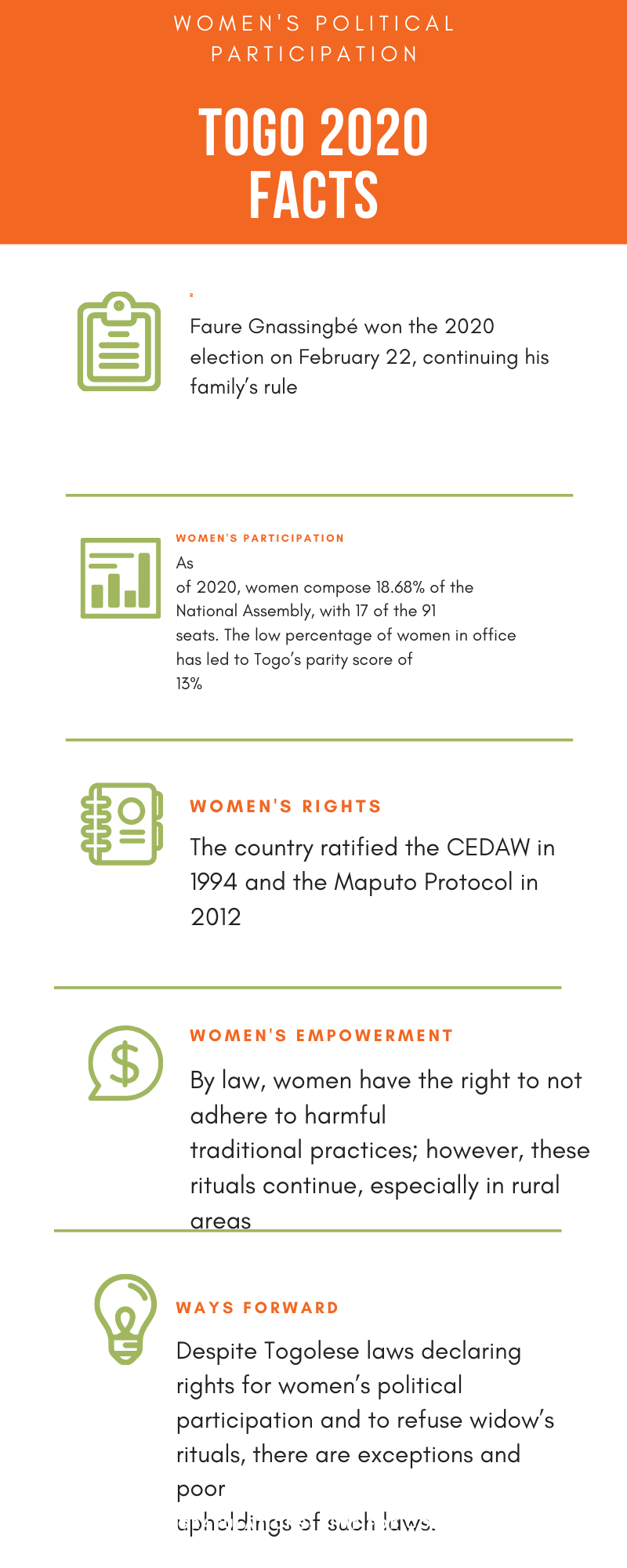Legislative elections took place in Togo on December 20, 2018. Despite a low election day turnout of 59%, by December 31, 2018, the Constitutional Court declared the election results valid. The ruling party of President Faure Gnassingbé, Union for the Republic (UNIR), lost several seats but still won the election with 59 seats held (out of 91 seats total). Their coalition partner, Union of Forces for Change (UFC), gained 4 seats, for a total of 6 seats. While election day itself was reported as being peaceful and calm, the period leading up to the election was marred with protests, violence and tensions running high across the country.
Throughout December protesters clashed with security forces, with 4 civilians killed on December 4. This follows up on waves of mass protests, starting in August 2017 against Gnassingbé, whose family has ruled Togo since 1967. Tens of thousands have joined the “Rise Up Togo” and “Faure Must Go” movements to call for a return to the 1992 constitution, which sets two term presidential limits and demand that this should apply retroactively for Faure Gnassingbé, barring him from any further Presidential runs.
Togo is a presidential republic, with a unicameral National Assembly. Although the country introduced multi-party democracy in the 1990s, the liberalization of the country has been overshadowed by the continuation of the Gnassingbé dynasty, power-sharing and the increasingly hostile environment towards opposition parties. In protest of status quo, all 14 major opposition parties boycotted the December 20 election, calling themselves the C14 coalition.
Togo amended its national electoral law in 2013 to include a new gender quota, requiring candidate lists to have equal numbers of women and men. Togo has also signed and ratified both the Maputo Protocol and CEDAW. Exact numbers of women elected in these elections is not clear yet, however this election marks the first time the 2013 gender quota will be in use and provisional reports say that UNIR had a candidate list composed of 45% women.
Women’s Political Participation
Data is still forthcoming on the gender breakdown of seats in the National Assembly following the election. Prior to this election, 16 seats were held by women, out of a total of 91, with women composing approximately 18% of the legislature. The previous cabinet had 6 female cabinet ministers.
Women have largely been absent from Togolese politics. In an attempt to rectify low levels of women’s political participation, the government introduced a 2013 law on Political Party and Electoral Campaign funding, allocating 20% of funding given to political parties in proportion to the number of women elected in previous legislative elections.
Overall, women in Togo have not occupied high profile positions in Togolese government. Bridgitte Kafui Adjamagbo-Johson, Togo’s first female presidential candidate, who later withdrew, is the possible exception; however Ms. Adjamagbo-Johnson is now the C14 opposition coalition leader. Another prominent female politician is Améganvi Isabelle, former UFC member and organizer of nation-wide sex strikes in 2012, but similarly following the deteriorating state of democracy, Ms. Isabelle has become active in the opposition movement. Farida Nabourema is another example of a former female politician, originally part of the UFC, but was routinely threatened and harassed. She now lives in exile but continues to play a critical role in the opposition movement, especially in organizing the Faure Must Go protests of 2017.
Women continue to play a very active role in civil society, advocating for greater freedom of speech rights and in particular for presidential term limits and the release of jailed opposition activists (hundreds were jailed in 2017). Generally, the slow inclusion of women and focus on gender equality by the Togolese government began in 2008 when the government introduced a national action plan for gender equality (PNEEG).
Nationwide gender equality remains an area of challenge in Togo. According to the Gender Inequality Index, Togo ranked 165th out of 189 countries, slipping further down the list from its 134th place in 2014. Examples such as women’s low literacy rate (73%) compared to men (90%), completion of primary education (79% for girls, 91% for boys) and women’s very limited land rights, further illustrate Togo’s gender inequality disparities. Furthermore, domestic violence is not specifically addressed within any legal frameworks in Togo and while rape is illegal, it is rarely reported or often ignored by authorities.
Conclusion
Given that electoral data with gender disaggregated numbers has yet to be released, the implications of the 2013 gender quota cannot yet be seen. Initial reports seem hopeful, noting the purported inclusion of many young people and women on the candidate lists of several parties. However, because of the largescale opposition boycott and the fragile democracy, women seem to be most active in opposition and protest movements, potentially shaping them into powerful agents of change or conversely, putting them at a heightened risk of harassment, detention and violence.

